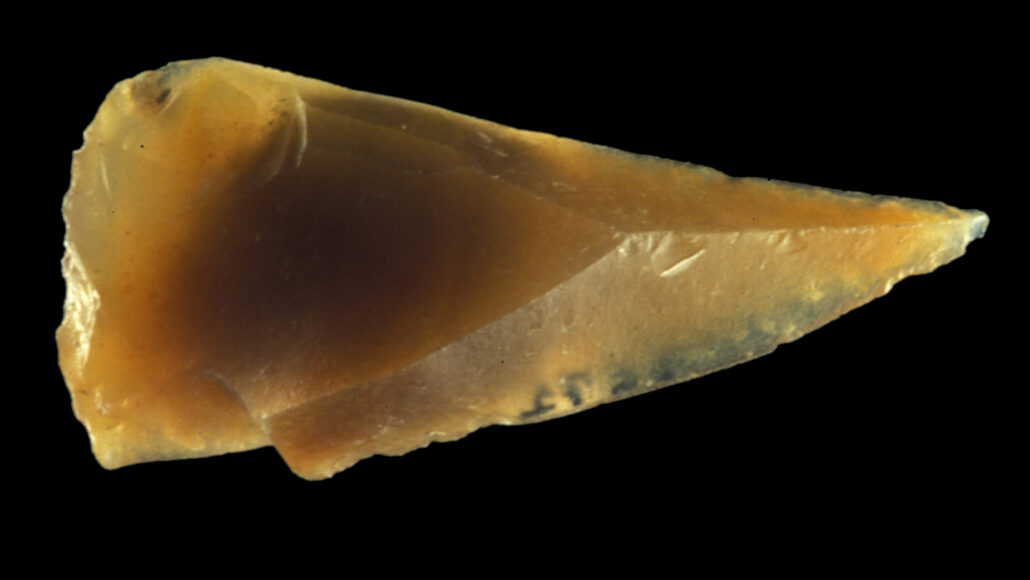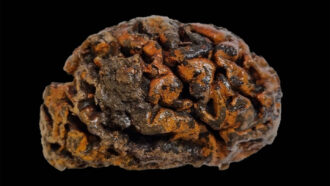Our species may have reached Europe while Neandertals were there
One French site shows periodic settlements by both ancient groups, but not at the same time

This sharp-edged stone point is evidence of the earliest known Homo sapiens settlement in Europe. It comes from a French rock-shelter and dates to as early as 56,800 years ago, researchers say.
L. Slimak
By Bruce Bower
Stone Age members of our species began migrating into Europe much earlier than most scientists had assumed. A study has now turned up evidence that Homo sapiens were living in what is now southern France up to 56,800 years ago. That’s 10,000 years earlier than the previous record.
The new fossil discoveries come from a rock-shelter in France. It sits 225 meters (738 feet) above the middle Rhône River Valley. Known as Grotte Mandrin, this site had been home to two closely related groups — H. sapiens and Neandertals — just not at the same time. These groups are regarded as different species by some scientists and as part of the same human species that we belong to by others. The two groups appear to have replaced each other at the French site a couple of times before Neandertals died out. That was roughly 40,000 years ago.
Ludovic Slimak is an archaeologist at the University of Toulouse-Jean Jaurès in France. He was part of the team that described the new findings from Grotte Mandrin February 9 in Science Advances. Until now, the prevailing view had been that Neandertals died out a few thousand years before modern humans (our species) entered Europe.
Slimak has directed excavations at the French site for the last 24 years. This work unearthed nearly 60,000 stone artifacts. It also turned up more than 70,000 bones of horses, bison and other animals.
Only nine isolated human teeth were found. Whether they came from Neandertals or H. sapiens can be determined by their shapes and sizes, the researchers say. The oldest H. sapiens material in the rock-shelter, includes a single tooth. It came from a 2- to 6-year-old child, Slimak says.
At least several dozen individuals made up the first settlement of H. sapiens at the French site, he estimates. Archaeological data indicate they lived there between 56,800 and 51,700 years ago. Those ancient people went on to stay for some 40 years. “This was not a short-term hunter-gatherer camp,” Slimak says. He likens it to a trial “colonization of Europe.”
That first settlement didn’t last. But there would be more.
The new evidence suggests groups of H. sapiens periodically entered southern Europe long before Neandertals went extinct, says Isabelle Crevecoeur. She works at the University of Bordeaux in France. She’s a paleoanthropologist who did not take part in the new study. More of our species came to Europe after the Neandertals died out. That, she concludes, “was probably the end of a long, sometimes unsuccessful, migration process.”
Sediments reveal a complex story
Each artifact or bone at Grotte Mandrin became buried over time. Slowly, dirt and debris blown in by strong winds settled over the ground. It covered things. The soil that developed now appears as 12 distinct layers. How deeply something had been buried serves as one measure of how old it is. But to be more precise, the scientists also used radiocarbon dating to establish the age of bone items. They also made calculations of how much time had gone by since each set of finds had been buried and when certain stones had been heated during toolmaking.
Resident Neandertals and ancient H. sapiens migrants had at least brief contacts, Slimak says. One hint to this: Flint the H. sapiens used to make tools came from sources located within 100 kilometers (62 miles) in all directions of the rock-shelter. Neandertals would have been well-versed in the region’s landscape. They likely helped our ancestors learn where to find that flint, Slimak says.
After H. sapiens’ 40-year stay, Neandertals moved into the rock-shelter. And it was hardly their first stay. Some Neandertals had lived at Grotte Mandrin as far back as 120,000 years ago, the researchers found. H. sapiens reoccupied the site roughly 14,000 years after their first visit. Neandertals left no signs of coming back after that.
In an unexpected twist, small stone points and blades found at Grotte Mandrin appear to have been made by H. sapiens some 56,800 years old. They match tools previously attributed to our species at a site in Lebanon. The Lebanese tools date to around 40,000 years ago. Archaeologists have struggled for more than a century to figure out who made the same types of stone tools at an earlier time at Grotte Mandrin and several other sites in the middle Rhône Valley.
It now appears there is an answer, Slimak says. Ancestors of the Lebanese toolmakers who lived in the ancient Middle East — even before H. sapiens entered Europe — may have traveled some 3,000 kilometers (nearly 2,000 miles) to reach Grotte Mandrin. Their trek likely included navigating vessels of some kind along the Mediterranean coast, Slimak suspects. Their toolmaking tradition, he says, could then have been passed down through many generations by groups living near the rock-shelter.
Stefano Benazzi is a paleoanthropologist at the University of Bologna in Italy. Although he was not part of Slimak’s team, he agrees it now seems H. sapiens arrived in Europe several times. In fact, Benazzi notes, “we cannot exclude that [our species] arrived even earlier than 56,000 years ago.”
But not everyone agrees on what to make of the Grotte Mandrin finds. A single H. sapiens tooth from somewhere between 56,800 and 51,700 years ago doesn’t prove who made tools found in the various sediment layers, says Clive Finlayson. He’s an evolutionary biologist at the Gibraltar National Museum. The toolmakers could have been H. sapiens or Neandertals.
Or even a hybrid of the two. Genetic evidence points to frequent mating between Neandertals and H. sapiens. To Finlayson, this poses some likelihood that hybrid offspring of such pairings might have made the stone tools at Grotte Mandrin.
To confirm the evolutionary identities of Grotte Mandrin’s Stone Age toolmakers, Slimak’s team is now attempting to extract ancient DNA from hominid teeth and sediments at the site.







